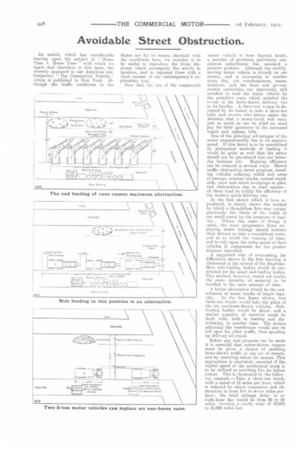Avoidable Street Obstruction.
Page 4

If you've noticed an error in this article please click here to report it so we can fix it.
An article, which has considerable -bearing upon the subject of " Motor Time v. Horse Time." with which we Again deal elsewhere in this issue, has recently appeared in our American contemporary " The Commercial Vehicle," which is published in New York. Although the traffic conditions in the States are by no means identical with the conditions here, we consider it to be useful to reproduce the three diagrams which accompany the article in question, and to expound these with a short resume of our contemporary's explanatory text. Now that the era of the commercial motor vehicle is here beyond doubt, a number of problems previously considered subordinate has assumed a premier position. Although the swiftlymoving motor vehicle is already on our streets, and is increasing in number every day, yet warehousemen, manufacturers, and the local and governmental authorities are apparentlystill satisfied to load the faster vehicle by the primitive ways which satisfied the owner of the horse-drawn delivery van in its heyday. A three-ton wagon is designed by its maker to take a three-ton load, and owners who labour under the delusion that a motor-truck will carry just as much as can be piled on must pay for their ignorance in the increased repair and upkeep bills. One of the principal advantages of the motor unquestionably lies in its superior speed. If this factor is to he neutralized by antiquated methods of loading it would be quite as well that the motor should not be introduced into our latter day business life. Running efficiency can be reduced in several ways. Slower traffic obstructing street progress, standing vehicles reducing width and areas of passage, tramcar tracks, central standards, snow and street sweepings in piles, and obstructions due to road repairs— all these tend to nullify the efficiency of the modern quick-delivery van.
In the first sketch which is here reproduced, is clearly shown the method by which a thoughtless firm may occupy practically the whole of the width of one small street for the purposes of loading. • Where this state of things is usual, the more progressive firms employing motor haulage should instruct their drivers to take a roundabout route, and so to avoid the wasting of time, and to rely upon the extra speed of their vehicles to compensate for the greater distance travelled.
A suggested way of overcoming the difficulties shown in the first drawing is illustrated in the second of the diagrams. Here side-loading bodies would be substituted for the usual end-loading bodies. This method, however, would not enable the same quantity of material to be handled in the same amount of time.
A better alternative would be the substitution of motor trucks of larger capa city. In the last figure shown, two three-ton trucks would take the place of the six one-horse-drawn vehicles. Sideloading bodies would be fitted, and a similar quantity of material could be dealt with, both in loading and distributing, in quicker time. The streets adjoining the warehouses would also be left open for other traffic, thus speeding up delivery all round.
Before any real progress can be made it is essential that motor-driven wagons must be given a chance of isolating horse-drawn traffic to one set of streets, and by reserving others for motors. This segregation is absolutely essential if the higher speed of the mechanical truck is to be utilized to anything like its fullest extent. This is illustrated by the. following example :—Take a three-ton truck, with a speed of 12 miles per hour, which is reduced by street congestion and obstruction to from five to seven miles perhour ; the total mileage delay in an eight-hour day would be from 40 to 50 miles. showing a yearly total of 12,000 to 16,000 miles lost.




















